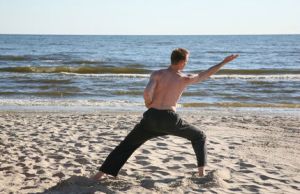
Qigong, also sometimes spelled Ch’i Kung, is an ancient Chinese healing system that has been practiced for thousands of years.
Its methods include combinations of meditation, breathing techniques and gentle motions to help qi, or vital energy, circulate optimally throughout the body.
The most well-known form of qigong in the western world is Tai Chi, also known as Taiji Quan. Tai Chi is, in essence, a graceful, slow-paced form of martial art, and when executed properly, appears much like a dance.
While Tai Chi focuses on exercising the body and mind as a whole, other qigong practices are targeted towards specific areas and systems of the body, in order to promote healing where it is needed most, for specific ailments.
Along with meditation, breathing and movement, traditional qigong emphasises a holistic lifestyle, including an organic diet, exercise and healthy sleep habits. When all of these areas are in harmony, healing can naturally take place.
The practice of qigong has been used for centuries to alleviate a wide and diverse array of maladies, one of which is headaches. In most cases, there is not one simple cause of a headache; they may be triggered by a number of issues throughout the entire body. As qigong addresses the energy flow throughout body systems, alleviation of headaches may be one natural result of getting back into balance.
Migraine headaches and tension headaches are sometimes due to lack of blood flow or oxygen flow to the brain, as well as tension in any part of the musculoskeletal system that is expressed in head pain. Qigong teaches certain postures that can improve blood flow throughout the body and brain.
Relaxation qigong is one form that is specifically designed to ease all forms of tension, including muscle tension, in the body and mind. If your headaches are caused by stress or anxiety, or an activity that is leaving a strain on your body, regularly practicing qigong can help alleviate it, making your tension headaches a thing of the past.
Another form of qigong is head and face qigong, which uses massage techniques on certain pressure points, such as the temples, along with breathing techniques, to alleviate tension and energy blockages specifically in these areas of the body. One practice within this form is massaging your temples and pressure points around your eyes to maximize relief.
 As with any form of meditation, the healing effects of qigong improve with ongoing, regular practice. If you are suffering from headaches, or just looking for a tranquil way to improve your physical and mental health overall, it may be of great benefit to look for qigong classes or activities in your area. Alternatively, much instruction is available online, for those looking to begin discovering this ancient practice from home.
As with any form of meditation, the healing effects of qigong improve with ongoing, regular practice. If you are suffering from headaches, or just looking for a tranquil way to improve your physical and mental health overall, it may be of great benefit to look for qigong classes or activities in your area. Alternatively, much instruction is available online, for those looking to begin discovering this ancient practice from home.
-The Alternative Daily
Sources:
http://www.qigonghealing.com/qigong/whatis.html
http://www.shen-nong.com/eng/exam/headaches_qigong_practice.html
http://www.chikung-unlimited.com/Migraine.html

